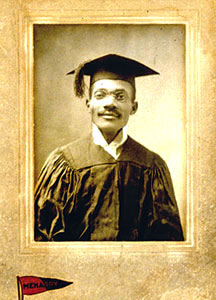
Meharry Medical College
Meharry Medical College in Nashville originated in 1876 as the medical division of Central Tennessee College, an institution established by the Freedman’s Aid Society of the Methodist Episcopal Church. The founding motivation was to train aspiring caregivers to serve not only newly freed African Americans but also all who were deprived of and needed medical attention. The founder and first president of Meharry Medical College was New Hampshire native George Whipple Hubbard (1841-1921), a former Union soldier who had received his medical degree from the University of Nashville. While still in school, Hubbard began the work of building Meharry with himself as sole instructor, religious advisor, and superintendent.
Meharry’s dental and pharmaceutical departments were organized in 1886 and 1889, respectively. There was only one member in the first graduating class in 1890; he held the degree of Master of Arts. In 1910 the School of Nursing of Mercy Hospital was transferred to Meharry. The Hubbard Hospital was built in 1912. On October 13, 1915, Meharry Medical College was granted a charter separate from Central Tennessee College, which had changed its name to Walden University in 1900.
On February 1, 1921, John J. Mullowney, a 1908 graduate of the University of Pennsylvania and a former faculty member of Girard College in Philadelphia, became the second president of Meharry. Under his leadership, admission requirements were rigorously administered; the number of faculty members increased; research and hospital facilities were expanded, increasing the bed capacity to one hundred; outpatient clinics were reorganized according to specialty; and a hospital superintendent was employed. In 1923 Meharry received an “A” rating.
With contributions from the General Education Board and the Rockefeller, Rosenwald, Eastman, and Carnegie foundations, together with assistance from the City of Nashville and Meharry alumni, the college moved from South Nashville to its present location in North Nashville, one street west of Fisk University, in the late 1920s. Thus began a long, mutually beneficial relationship between the schools. Initially, some buildings served both institutions. The later Neo-Gothic and College-Gothic architecture of the two schools’ buildings would reflect the symbiotic relationship between Fisk and Meharry. By the 1930s many aspiring physicians had obtained their undergraduate and premedical education at Fisk and later graduated with their medical degrees from Meharry.
In 1938 the distinguished scholar Edward L. Turner assumed the post of president. Turner modified the curriculum of the medical school, insisting on a more scientific approach and stressing the importance of proper clinical procedures. During this time, Meharry began to experience financial difficulties, which plagued the institution throughout the 1940s. Turner resigned in 1944. Dr. M. D. Clawson served as president of Meharry from 1945 to 1950.
An interim administrative committee directed affairs until 1952, when Dr. Harold D. West, the first black president of the school, began his term. Under West the school launched a $20 million fund drive, purchased land adjacent to the campus, and added a wing to the hospital. The school redefined its purpose, terminating the School of Nursing and the Division of Dental Technology in the early 1960s. Significant improvements also were made to the curriculum and facilities in the schools of medicine and dentistry.
From 1966 to 1968 an interim committee managed Meharry until the former dean of the medical school, Lloyd Elam, was appointed president. Meharry then established a graduate school offering the Ph.D. degree in the basic sciences and a School of Allied Health Professions in conjunction with Tennessee State University and Fisk University. New buildings for the schools of medicine and dentistry and a new hospital were constructed in the 1970s. Elam provided Meharry with thirteen years of progressive leadership and continued his service to the school as a distinguished member of the teaching faculty.
In March 1981 Richard Lester, chairman of the Department of Radiology of the University of Texas Science Center and a member of Meharry’s board of trustees, assumed the duties of interim president for one year. In July 1982 David Satcher became the third black man to hold the position of president. Satcher rose to national prominence and was appointed director of the United States Center for Disease Control in Atlanta in 1993. In 1997 President Bill Clinton nominated Satcher to the position of surgeon general of the United States; he was confirmed the following year.
The reins of Meharry were passed to Dr. John E. Maupin Jr., the first alumnus and graduate of Meharry’s School of Dentistry to become the institution’s top administrator. Maupin became the ninth president on July 1, 1994. He was charged with overseeing construction and renovation of facilities, merging the respective clinical staffs, and accomplishing the monumental job of solidifying the national community around the continued viability of Meharry Medical College. Maupin also would orchestrate the inauguration of the merged facilities on January 1, 1998.
Meharry Medical College includes the School of Medicine, the School of Dentistry, the School of Graduate Studies and Research, the School of Allied Health Professions, the Metropolitan General Hospital of Nashville-Davidson County, two health centers, and the Harold D. West Basic Sciences Center.
Suggested Reading
Charles V. Roman, Meharry Medical College, A History (1934); James Summerville, Educating Black Doctors: A History of Meharry Medical College (1983)



